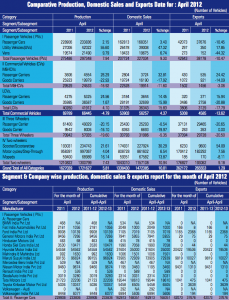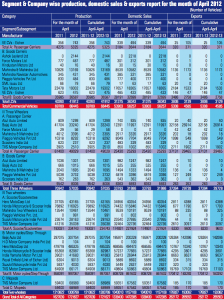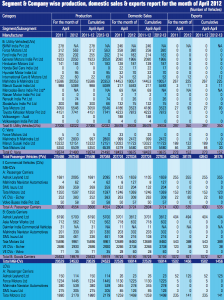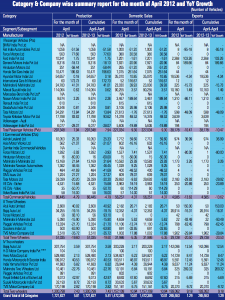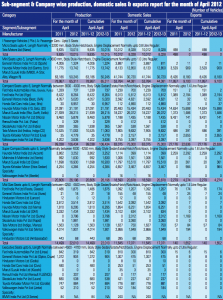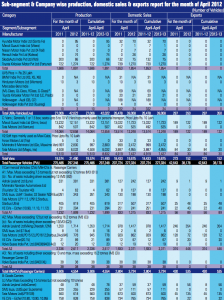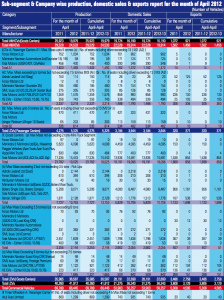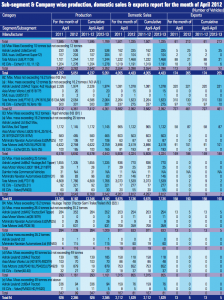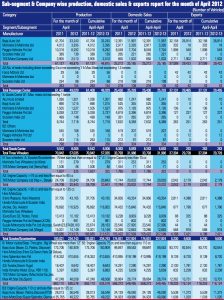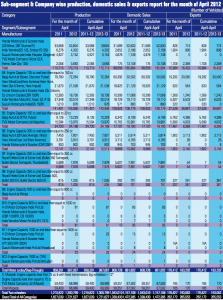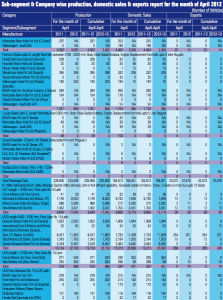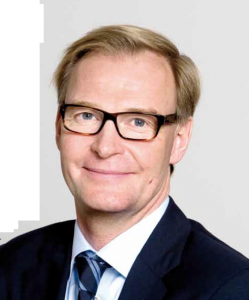 For the full year 2011, the Volvo Group generated the highest-ever net sales, operating income and operating margin to date. Mr. Olof Persson, President and CEO, Volvo Group, says: “We put the best year ever under our belt, and I can proudly state that all the hard work of the Volvo Group’s employees to deliver the best products, services and after-sales service generated results.”
For the full year 2011, the Volvo Group generated the highest-ever net sales, operating income and operating margin to date. Mr. Olof Persson, President and CEO, Volvo Group, says: “We put the best year ever under our belt, and I can proudly state that all the hard work of the Volvo Group’s employees to deliver the best products, services and after-sales service generated results.”
Net sales rose to SEK 310 billion (265), operating income improved to SEK 26.9 billion (18.0) and the operating margin was 8.7 per cent (6.8). At the same time, return on operating capital in the Industrial Operations rose to 28.8 per cent and on shareholders’ equity in the Group to 23.1 per cent. “We have now taken the first steps on a journey which will be full of challenges, but I am convinced that there is potential to increase sales and improve profitability over time”, he adds.
 The Volvo brand reaped great success and in the heavy-duty segment in Europe increased its market share to a record 16 per cent. The European market weakened somewhat towards the end of the year, but after that stabilized at the new, slightly lower level.
The Volvo brand reaped great success and in the heavy-duty segment in Europe increased its market share to a record 16 per cent. The European market weakened somewhat towards the end of the year, but after that stabilized at the new, slightly lower level.
Market shares in North America also picked up equally well. In the US, Volvo and Mack had a combined 19.8 per cent of the market for heavy-duty trucks. In Brazil, Volvo’s market share rose to 17.1 per cent for heavy-duty trucks and, for the first time, it is the leader in the heavy-duty truck segment.
Volvo Construction Equipment (Volvo CE) also strengthened its position in several growth markets worldwide. In China its brands, Volvo and SDLG, advanced as market leader within wheel loaders and excavators. SDLG which recently launched new models of excavators hopes that the success in the giant market will continue. Volvo hybrid buses are also attracting demand all over the world.
Increased profitability
Good market conditions in the main and increasing market shares driven by competitive products translated into Volvo delivering close to 238,000 trucks during 2011 – an increase of 32 per cent compared to the preceding year. Net sales in truck operations surpassed SEK 200 billion and profitability improved to an operating margin of 9.1 per cent.
From a historic perspective, Volvo Buses had a good year, both in terms of volumes and profitability. This was achieved by successful efforts to grow in emerging markets, which offset the continued weak markets in Europe and the US. Operating income increased to SEK 1 billion and operating margin improved to 4.6 per cent, which is below the group average but good when compared to competitors.
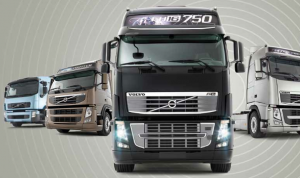 “During my predecessor Leif Johansson’s 14 years as CEO, the Volvo Group established itself as one of the world’s largest manufacturers of commercial vehicles with strong positions in mature markets and with an increasingly important presence in growth markets. As a step in further streamlining the Volvo Group towards commercial vehicles, during the year we initiated a process aimed at divesting Volvo Aero”, says Mr. Persson.
“During my predecessor Leif Johansson’s 14 years as CEO, the Volvo Group established itself as one of the world’s largest manufacturers of commercial vehicles with strong positions in mature markets and with an increasingly important presence in growth markets. As a step in further streamlining the Volvo Group towards commercial vehicles, during the year we initiated a process aimed at divesting Volvo Aero”, says Mr. Persson.
Growing Indian market
The Indian market is in an exciting growth phase with increasing investments in infrastructure. The Volvo Group’s joint venture company VE Commercial Vehicles (VECV), formed in 2008, comprises the entire Eicher Motors truck and bus operations and the Volvo Group’s Indian sales operations in the truck segment as well as the service operations for trucks and buses. The Indian market for heavy-duty trucks grew by 12 per cent to 237,000 trucks in 2011 compared to 212,000 vehicles in 2010. The market for light and medium-duty trucks grew by 19 per cent to 103,000 vehicles (87,000). With 11 per cent of the total Indian market for commercial vehicles, i.e., heavy-duty, medium-duty and light-duty trucks as well as buses, Eicher is India’s third largest manufacturer of commercial vehicles.
The position is especially strong in the light and medium-duty segment in which Eicher during 2011 had a market share of 30.5 per cent (30.5). In heavy-duty trucks the market share is developing in the right direction, although from low levels, since Eicher during 2011 launched its, new heavy-duty truck program based on the cooperation in VECV. During 2011, Eicher had 3.1 per cent of the market in the heavy-duty segment compared to 2.0 per cent the year before, and the overall idea is to grow within heavy-duty trucks in the coming years.
VECV’s facility at Pithampur is in for rapid expansion. Part of the new construction taking place is the SEK 480 M investment in the production of the Volvo Group’s new global medium-duty engine. The investment gives the group a complete facility in India for processing and assembling the new medium-duty engine, which will be introduced in the group’s trucks and buses worldwide in the next few years.
Through this investment, it will be possible for the Volvo Group to locate most of its production of medium-duty engines to VECV’s plant at Pithampur. VECV has an established supplier base in India and efficient purchasing channels, and already today VECV produces about 40,000 engines per year at the existing plant. The group will now have an engine platform that combines the latest in Japanese technology with India’s highly competitive production cost. The investment in Pithampur will result in an annual production capacity of an additional 85,000 new medium duty base engines.
In addition to production of the base engine itself, the Pithampur facility will also conduct final assembly of engines for India and all of Volvo Group’s global markets with Euro III and Euro IV emission requirements. By gathering base engine production in India, it will be possible for the company to meet the group’s need for cost-efficient medium-duty engines in Asia, while also contributing to an increase in its competitiveness in the medium-duty segment in other markets. Production of medium-duty engines in Pithampur is likely to start this year.
Bright days ahead for Volvo Buses
In its 10th year in India, Volvo Buses announced a SEK 500 M investment plans for the next five years. In the first phase the company will expand its current industrial establishment and introduce a range of new products. Over the last decade the company has emerged as a leader in its class with a dominant market presence and in the process redefined how people see buses.
The Indian market has witnessed a paradigm shift in the bus business. While earlier coaches built on truck chassis were the norm of the day, the entry of Volvo Buses introduced the concept of a true-bus chassis with rear engines. Volvo Buses also brought in the idea of BRT, efficient, bus-based public transport systems.
Mr. Akash Passey, formerly head of Volvo Buses in India, and currently Senior VP Business Region International and Chairman of the Board of Volvo Buses in India, said: “The need for buses as sustainable transport solutions is high in India, and we aim to grow multifold in the years to come – from 1,000 buses to 5,000 buses, from 1,000 people to 5,000 people and be a billion dollar company by 2015.”
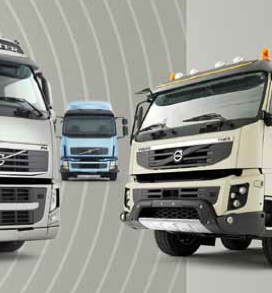 By 2015, Volvo aims to export 20-25 per cent of its volumes not only in South Asia but also to markets beyond. Volvo Buses today has over 70 per cent market share in the luxury inter-city coach segment and over 50 per cent market share in the low-floor air-conditioned city bus segment respectively. Towards the end of 2011, Volvo Buses launched three new city buses and coaches in India, and thus increased the product range to encompass 10 buses.
By 2015, Volvo aims to export 20-25 per cent of its volumes not only in South Asia but also to markets beyond. Volvo Buses today has over 70 per cent market share in the luxury inter-city coach segment and over 50 per cent market share in the low-floor air-conditioned city bus segment respectively. Towards the end of 2011, Volvo Buses launched three new city buses and coaches in India, and thus increased the product range to encompass 10 buses.
Global outlook
Continued earnings improvement in 2011 was characterized by a continued recovery in demand in the group’s mature markets and a continued strong development in the emerging markets. Towards the end of the year the first signs of a moderate slowdown were visible in Europe.
Demand in Europe and North America increased during the year, but towards the end of the year it weakened in Europe. The Japanese market was adversely affected by the earthquake and tsunami that hit the country in March, but recovered towards the end of the year. In Brazil demand was strong during the year.
In 2011 the heavy-duty truck market in Europe 29 (the EU, Norway and Switzerland) expanded by 35 per cent to 242,400 trucks compared to 2010. The situation still varied significantly within Europe. While parts of southern Europe were struggling, the other regions in northern and eastern Europe had recovered from the low levels of 2010. In 2012, the total market for heavy-duty trucks in Europe 29 is expected to experience a moderate decline to a level of about 220,000 trucks. The start of the year is expected to be slow with a gradual pick-up in demand as customers start to renew their fleets ahead of the new emission regulation in 2014.
In 2011, the total market for heavy-duty trucks in North America increased by 52 per cent to 216,100 units compared to 142,100 units in the previous year. In 2012, the total market for heavy-duty trucks in there is expected to grow to a level of 250,000 trucks.
In 2011, the total market in Brazil expanded two per cent to 111,500 heavy-duty trucks (109,800). The increase was lower than anticipated because of less prebuying than expected ahead of the new, stricter emission regulation that came into effect on January 1, 2012. The total Brazilian market for heavy-duty trucks is expected to record a slight decline and reach a level of 105,000 trucks in 2012. The beginning of the year is expected to be slow followed by a gradual pick-up in demand driven by a general increase in economic activity and increased acceptance of the new, more expensive Euro V trucks.
